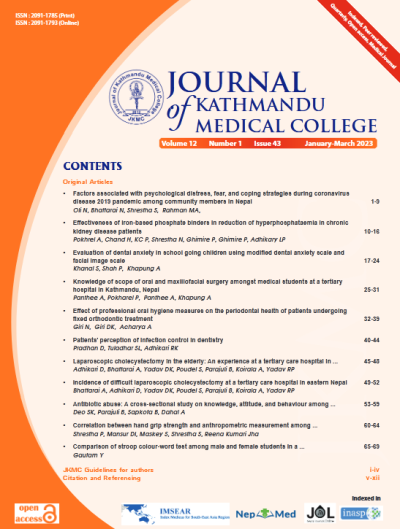Laparoscopic cholecystectomy in the elderly: An experience at a tertiary care hospital in Eastern Nepal
DOI:
https://doi.org/10.3126/jkmc.v11i4.53552Keywords:
Cholelithiasis, Elderly, Gall bladder, Laparoscopic cholecystectomyAbstract
Background: The prevalence of laparoscopic cholecystectomy in Nepal ranges from 2.44% to 6.45%. The prevalence of gallstones increases with age. Age is considered to be one of the major risk factors in determining the results of morbidity and mortality during laparoscopic cholecystectomy. Laparoscopic cholecystectomy is the gold standard modality for the management of gallstones.
Objectives: The aim of this study was to determine the clinical outcome of laparoscopic cholecystectomy in the elderly.
Methods: This was a descriptive cross-sectional observational study done after ethical clearance. Retrospective data were included of all the patients’ aged ?60 years who underwent laparoscopic cholecystectomy at Nobel Medical College Teaching Hospital, Biratnagar, Morang, Nepal from 2021 July to 2022 June using convenience sampling. Data were entered in Microsoft Excel Sheet and descriptive findings are presented.
Results: A total of 1688 laparoscopic cholecystectomies were performed during the study duration. Consecutively, 250 elderly patients who underwent were included in the study. The mean age of the elderly was 67.88 years. The incidence of the elderly at the institute was 26.7% (452/1688). In the present study, 95 (38%) elderly patients had some kind of comorbidities. Isolated intraoperative complications were seen in 26 (10.4%) patients. Post-operative complications were seen in 53 (21.2%) patients. The need to convert laparoscopic cholecystectomy to open cholecystectomy was observed in 3 (1.2%).
Conclusion: For the elderly, laparoscopic cholecystectomy is a safe and reliable modality. They benefit from this mode of treatment without increasing the risk of surgery.
Downloads
Downloads
Published
How to Cite
Issue
Section
License

This work is licensed under a Creative Commons Attribution-NonCommercial 4.0 International License.
Copyright © Journal of Kathmandu Medical College
The ideas and opinions expressed by authors or articles summarized, quoted, or published in full text in this journal represent only the opinions of the authors and do not necessarily reflect the official policy of Journal of Kathmandu Medical College or the institute with which the author(s) is/are affiliated, unless so specified.
Authors convey all copyright ownership, including any and all rights incidental thereto, exclusively to JKMC, in the event that such work is published by JKMC. JKMC shall own the work, including 1) copyright; 2) the right to grant permission to republish the article in whole or in part, with or without fee; 3) the right to produce preprints or reprints and translate into languages other than English for sale or free distribution; and 4) the right to republish the work in a collection of articles in any other mechanical or electronic format.




